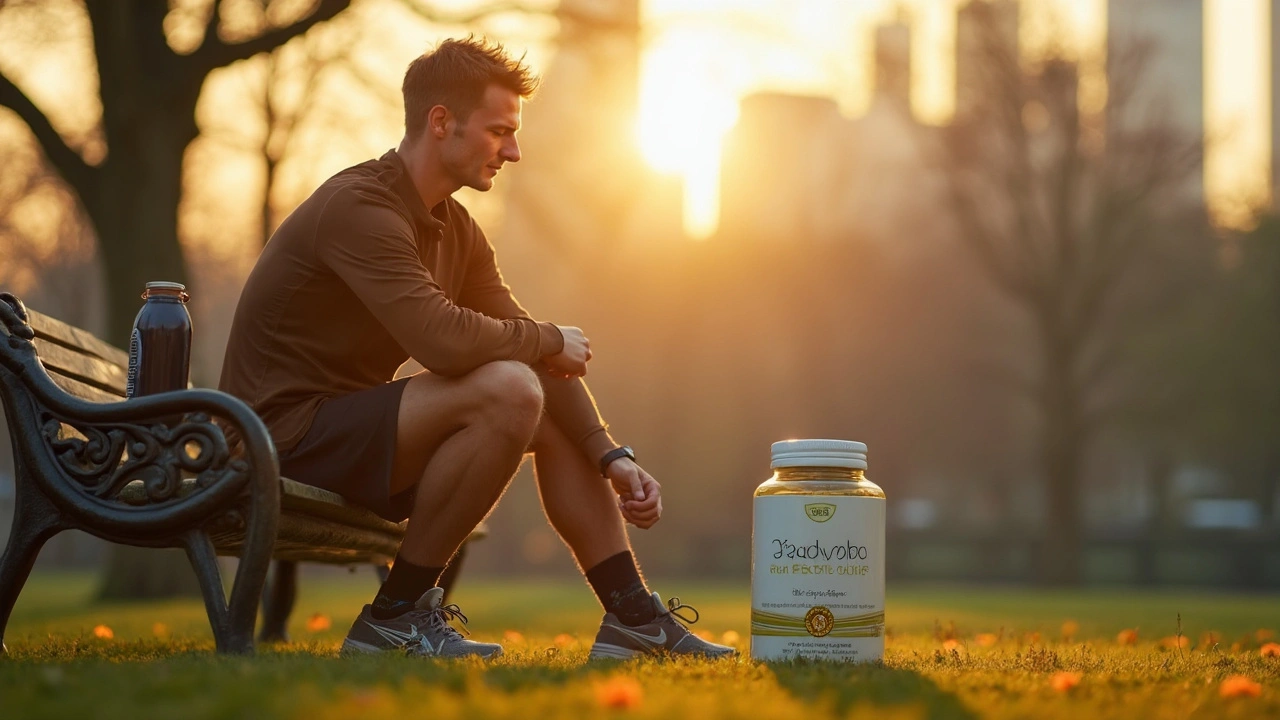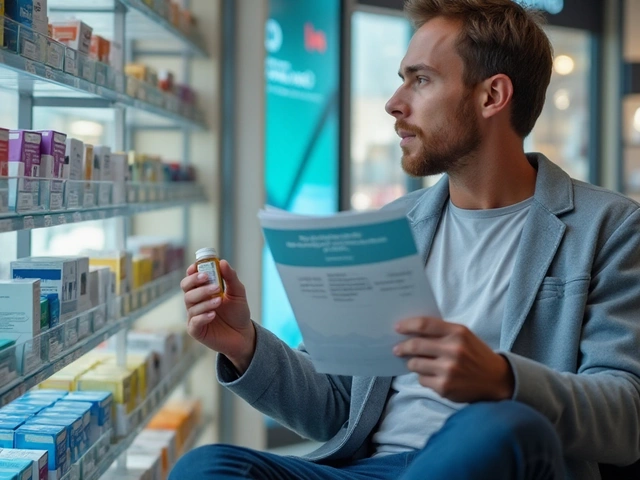
Ever feel like coffee just isn’t cutting it anymore? There’s a new herb showing up in gym bags and on Reddit forums—Fadogia Agrestis. Some folks swear it gives them a real boost, especially when it comes to energy for workouts or even busy work days.
Now, Fadogia Agrestis isn’t some magic potion, but it does have its roots (literally) in traditional African medicine. In Nigeria, people have used it for ages to help with physical stamina and performance. Fast forward to now, and you’ll see capsules of this stuff on supplement shelves, aimed at folks chasing a little more zip in their day.
If you’re tired of feeling run down or want to see if your workouts could get an edge, it’s worth knowing what this plant extract actually does, the science behind it, and the smartest way to take it. Let’s break it down without any hype—just the real info so you can decide if Fadogia Agrestis is worth adding to your routine.
- What Exactly is Fadogia Agrestis?
- How Does It Work in the Body?
- Benefits for Energy and Performance
- How to Use Fadogia Agrestis Safely
- What Science Actually Says
- Tips Before You Buy or Try
What Exactly is Fadogia Agrestis?
Fadogia Agrestis is a shrub that grows mainly in Nigeria and some other parts of West Africa. You’ll hear about it mostly from folks looking to boost energy and support physical performance, but really, it’s been used in folk medicine for way longer than modern supplement trends.
The plant itself isn’t anything fancy to look at—sort of bushy, grows wild, and the part people use is mostly the stem. Nigerian healers have made teas and extracts out of it for things like tiredness and men’s health.
Most of the supplements you see today use the dried and powdered stem, or sometimes an extract of the whole plant. What gets people’s attention are special compounds in it called saponins. In animal research, these seem to play a role in raising testosterone levels, which is one reason athletes and gym-goers are interested.
Here’s a quick breakdown of the basics:
- Botanical name: Fadogia agrestis
- Native to: Nigeria, West Africa
- Plant part used: Mostly stem, sometimes whole plant
- Main active compounds: Saponins, alkaloids, flavonoids
- How it’s used: Usually as capsules, powders, or liquid extracts
If you like seeing numbers, here’s a look at how it shows up in supplements today:
| Form | Typical Dose |
|---|---|
| Capsule | 300-600 mg daily |
| Powder | 1/4 to 1/2 tsp mixed into drinks |
| Liquid Extract | 10-20 drops |
Bottom line? Fadogia Agrestis has been around for years in traditional medicine, but it only recently got popular in the modern world as a go-to for people wanting more energy and physical drive. Knowing where it comes from and what’s actually in it is the first step before you consider trying it out yourself.
How Does It Work in the Body?
If you’re looking for hard facts about Fadogia Agrestis, here’s what’s known. This herb comes from a shrub found in Africa, and it’s the plant extract people usually talk about when discussing energy and performance hacks.
The spotlight is mostly on one thing: testosterone. Early animal research (mainly studies with rats) shows that Fadogia Agrestis may help crank up natural testosterone. This hormone isn’t just for muscle—it’s tied to your energy, mood, workout recovery, and even your drive to get up and do stuff. Some researchers saw serum testosterone in rats increase three to six times in about a week after taking the supplement. That sounds wild, but remember, these are rats—not humans.
So, how does it seem to do all this? The main idea is that it nudges the body's own system to make more testosterone. There’s a hint it might help the secretion of luteinizing hormone (LH), which is basically the signal your brain sends to your body, telling it to produce testosterone.
Besides cranking up testosterone, some people report a bit more pep in their step and even faster recovery after tough gym days. It might also help blood flow—another plus for performance.
- Unlike caffeine, Fadogia Agrestis isn’t a stimulant. You won’t get that jittery crash.
- It doesn’t work instantly. You’ll see results (if you do) after taking it daily for about a week or more.
- Dosage, body size, and overall health all make a difference in how it will work for you.
If you’re curious, here’s a quick look at how some of these impacts have shown up in animal studies:
| Test Group (Rats) | Serum Testosterone Change | Duration |
|---|---|---|
| Low Dosage | 2x increase | 7 days |
| Medium Dosage | 3.5x increase | 7 days |
| High Dosage | 6x increase | 7 days |
No one’s promising these boosts in humans just yet, but that’s the direction current research is pointing. Bottom line: Fadogia Agrestis seems to tap into your body’s own ways of boosting performance, instead of just giving you a temporary rush.
Benefits for Energy and Performance
If you’re looking at Fadogia Agrestis because you want more energy or to step up your game in the gym, you’re definitely not alone. This herb has shot up in popularity mainly because some early research and loads of user stories point toward good things for physical performance and stamina.
Here’s what stands out about Fadogia Agrestis and why folks keep talking about it:
- Energy Boost: Fans claim they feel noticeably more alert and less fatigued when using Fadogia Agrestis, especially before workouts or sports. That’s a big reason it’s gotten attention from athletes and fitness buffs.
- Supports Physical Performance: Early animal studies—yeah, mostly on rats so far—showed increased activity, endurance, and even willingness to run longer and harder. That’s why it’s become a talking point in strength and bodybuilding communities.
- Potential Testosterone Support: Some people use Fadogia Agrestis because of its reputation for nudging up natural testosterone levels. Higher testosterone is tied to better energy, faster muscle recovery, and more drive during workouts. Keep in mind, actual effects on humans are still being studied, and the noticeable boost some users report is still mostly anecdotal.
- Helps with Recovery: People also mention bouncing back faster from tough sessions—less next-day soreness and more motivation to get after it again.
To show you how Fadogia Agrestis stacks up compared to other natural options, here’s a simple look at what people say:
| Supplement | Energy Boost | Performance | Common Use |
|---|---|---|---|
| Fadogia Agrestis | High | High | Workout stamina, testosterone support |
| Ashwagandha | Medium | Medium | Stress, mild energy |
| Ginseng | Medium | Medium | General energy and focus |
If you’re thinking about giving Fadogia Agrestis a try, know that the biggest wins seem to come in energy, motivation, and gym performance. Lots of people stack it with other supplements for even better effects, but make sure to listen to your body and don’t jump in too fast. Always start with a lower dose to see how your system responds.

How to Use Fadogia Agrestis Safely
Starting with Fadogia Agrestis isn’t rocket science, but you do want to be smart about it. There’s no “official” dose, since studies on humans are pretty thin, but most supplement bottles recommend anywhere from 300 to 600 mg per day. It’s usually taken as a capsule or powder, and many folks start on the lower end to see how their body reacts.
Here are a few basic tips so you get the best out of your new routine and avoid rookie mistakes:
- Don’t double up. Stick to the daily recommended dose on the product label. A higher dose doesn’t mean better results—it could just mean more side effects.
- Take it with food. A lot of people say this helps their stomach handle it better. You don’t want your gut feeling off right before work or a gym session.
- Cycle it. Some trainers recommend using Fadogia Agrestis for a few weeks, then taking a break (for example: 8 weeks on, 4 weeks off). This can help your body not build up a tolerance and keeps things feeling fresh.
- Watch for side effects. Pay attention to anything unusual—cramps, stomach upset, or feeling jittery. Most reports say mild side effects, but everyone’s different.
- Avoid mixing with other potent supplements. Especially the ones that claim to increase testosterone or give crazy energy, unless you’ve already checked with your doctor.
People sometimes get excited and want to stack this herb with other stuff. Just a heads up—there haven’t been good studies on mixing Fadogia Agrestis with other herbs or prescription meds, so talk to a healthcare pro if you’re on any daily meds or managing conditions like high blood pressure.
With supplements, quality matters. Not all brands test their stuff. Look for third-party certification or lab testing, and be careful buying from random websites.
| Common Dose (Daily) | Form | Cycle Suggestion |
|---|---|---|
| 300–600 mg | Capsule or powder | 8 weeks on, 4 weeks off |
Bottom line—start slow, don’t mix recklessly, and pay attention to your body. That’s how you make Fadogia Agrestis part of a safe and smart supplement routine.
What Science Actually Says
Let’s get straight to what actually backs up or busts the hype around Fadogia Agrestis. Most of the buzz comes from early animal studies—mainly with rodents, not people. Researchers in Nigeria ran trials where they gave Fadogia Agrestis extract to male rats, and they noticed a jump in testosterone levels, as well as an increase in physical activity and sex drive. That’s where all the performance, stamina, and "energy boost" claims started.
If you’re hoping for strong human research, here’s the honest deal: As of now, peer-reviewed studies on actual Fadogia Agrestis use in people are extremely limited. There just aren’t big clinical trials yet that prove it works for boosting energy or performance in us the way it did in rats. Some supplement companies point to the animal data as promising, but real human science is still catching up.
Here’s a quick snapshot of what animal studies have found so far:
- Testosterone can rise 2-6 times in rats, depending on dose and duration.
- Some studies saw improved muscle strength and more “mounting behavior”—which is basically a scientific way of saying better libido in male rats.
- There are possible protective effects on the liver and kidneys in certain studies, but also some signs of toxicity if the dose is too high, especially to the testes.
| Key Finding | Species Studied | Dosage |
|---|---|---|
| Testosterone Boost | Rat | 18mg-100mg/kg body weight |
| Improved Libido | Rat | 18mg-100mg/kg body weight |
| Liver Support (some evidence) | Rat | Varies |
As for humans? Folks who take Fadogia Agrestis sometimes report feeling more energetic, motivated to exercise, or seeing a libido bump. But this is all anecdotal—real science hasn’t caught up to these stories. Plus, no one’s mapped out long-term safety or possible side effects in humans.
Bottom line: It’s an experiment, not a sure thing. If you do try Fadogia Agrestis, stick to recommended doses and keep an eye out for new research as it comes in. And if you want energy, you’re better off mixing good sleep, nutrition, and exercise with any supplement you use.
Tips Before You Buy or Try
Look, before you throw a bottle of Fadogia Agrestis into your cart, a little homework goes a long way. The supplement world is kind of the Wild West, so here’s what you need to know before you jump in.
- Check for purity and authenticity. Only buy from brands that clearly share where their Fadogia Agrestis comes from, and if possible, publish third-party testing results. No one wants mystery fillers or fake stuff in their capsules.
- Look at the dosage. Most supplements you’ll find online contain 300mg to 600mg per capsule. There’s no official standard, but some folks stick to around 600mg a day. Start low and see how you feel.
- Read the ingredient list. Some brands toss in extra herbs, caffeine, or who-knows-what. Find a product with just Fadogia Agrestis extract, unless you want those bonus ingredients.
- Talk with your doctor. If you’re pregnant, on meds, or have health issues, check with a professional. There aren't enough long-term studies, especially for people with medical conditions.
- Watch for side effects. Some users report testicular discomfort, stomach issues, or mood swings when taking higher doses. If something feels off, stop immediately.
If you like to geek out on numbers, here’s a quick snapshot of what you’ll see on supplement labels:
| Brand Example | Common Capsule Strength | Other Ingredients |
|---|---|---|
| Nootropics Depot | 300mg | Vegetable Capsule |
| Double Wood Supplements | 600mg | None (pure extract) |
| Bulk Supplements | Powder (varied) | None |
One last thing: Don’t expect instant results. Some folks feel a change in energy after a week, others need up to a month. Patience is key, and track how you feel so you know if it’s working for you or not. And remember, no supplement can replace sleep, food, and good old exercise.




Ari Kusumo Wibowo
July 18, 2025 AT 16:46Yeah, I gotta admit, I was super skeptical about Fadogia Agrestis when I first heard about it. I mean, supplements get hyped up all the time, but this one seems to be gaining serious buzz. From what I read, it’s not just some random herb but actually has some solid science behind it boosting testosterone and energy levels.
Now, I’m curious though—are we sure about the safety stuff? Like, supplements that mess with hormones usually have some strings attached. Anyone here tried it for a few weeks and noticed any weird side effects?
Also, is it just for gym rats or could regular folks get a legit energy boost from it? I’m thinking of adding it to my stack but want to get as much info as possible first. Don’t wanna waste money on another dud!
Tatiana Akimova
July 18, 2025 AT 17:46Omg yes!!! I’ve been using Fadogia Agrestis for about a month now, and I can honestly say it’s a game-changer for my workouts and energy throughout the day. Seriously, my stamina feels insane. I was kinda on the fence too but decided to leap because I needed a boost beyond just caffeine.
Just a heads-up though, you gotta be careful with the dosage. I started low and ramped up slowly as suggested in some forums. No crashes, no jitters—just pure natural energy. Plus, I love that it’s herbal; feels much better than synthetic stuff.
Anyone else combining it with other supplements? Would love to hear what works best alongside it.
Calandra Harris
July 18, 2025 AT 18:46People always looking for shortcuts, huh? Fadogia Agrestis ain’t some magic bullet. If you really want performance, it’s discipline and proven training—not some herb that might barely move the needle. Honestly, I don’t get why folks jump on every hype train.
Sure, it supposedly boosts testosterone, but at what cost? Your body’s balance is delicate and messing with hormones without understanding the long-term effects is just reckless. This blind trust in supplements can backfire badly.
Rather than chasing every new herbal fad, why not invest in solid nutrition, good sleep, and actual science-backed methods? Just saying.
olivia guerrero
July 18, 2025 AT 19:46Wow!!! This is such an exciting topic!! 🤩 I’m always thrilled when natural supplements show promise in enhancing energy and performance—especially when they’re less known like Fadogia Agrestis!!
From everything I’ve read, the fact that athletes and biohackers are buzzing about this herb says a lot!!! It’s fascinating how nature keeps gifting us with these powerful resources!!
However!!!!! As an optimist, I urge everyone to be super cautious!!! Always research and consult health professionals before adding anything new!! Your health is your best asset after all!!!
Dominique Jacobs
July 19, 2025 AT 06:40Alright, I wanna jump in here because I actually tried Fadogia Agrestis for a solid six weeks after reading the buzz. The initial energy spike was for real, like I felt motivated to push harder at the gym and stay alert at work. But around week four, stuff got a bit weird—energy wasn’t steady and I experienced mood swings.
Has anyone else seen this? Are we sure it’s safe long term? I get that it’s natural, but nature isn’t always harmless either. Would love to hear your experiences because I’m kinda torn between continuing and stopping.
Also, any thoughts on stacking it safely with other supplements like Ashwagandha or Rhodiola?
Claire Kondash
July 23, 2025 AT 05:06In contemplating the essence of Fadogia Agrestis, one cannot help but marvel at the intersection of ancient botanical wisdom and modern performance enhancement. 🌿✨ The bioactive compounds seemingly ignite a cascade of physiological responses that elevate stamina and vitality beyond mere placebo.
Yet, it behooves us to reflect deeply on the intricate balance between augmentation and natural harmony. Is the pursuit of elevated energy a boon or a subtle way to disrupt the delicate ecosystem of our inner workings? 🤔
Such questions invite a philosophical discourse on the essence of human enhancement and the ethical stewardship of our bodily temple.
Matt Tait
July 26, 2025 AT 05:20Look, the supplement market is flooded with stuff like this, and most of it barely delivers. Fadogia Agrestis? Sounds like just another gimmick to me, and honestly, I don’t have the time or patience to follow some herbal fad that might mess with my hormones.
If you’re looking for results, sticking with what’s proven—the basics—is smarter. Training hard, eating right, and getting sleep beats throwing cash on some mysterious plant. Also, who regulates this stuff? Nothing guaranteed.
Just my two cents, but trust me, don't let hype cloud your judgment. End of story.
Benton Myers
July 30, 2025 AT 20:26I'm just watching this convo quietly, but curious—does anyone know if Fadogia Agrestis has any documented interactions with common medications? Like for people with usual health conditions, is it generally safe or a potential risk?
Seems like the community is split between hardcore proponents and skeptics. Would like to see more clinical data before making any moves though.
Anybody got links to legit studies or personal experiences that could shed light here?
Pat Mills
August 6, 2025 AT 19:06This whole debate around Fadogia Agrestis actually highlights something deeper about how we view supplements and health !!! For those who seek a boost, it’s often a reflection of a desire to push limits or reclaim vitality lost in a fast-paced world.
But the dramatic swings in opinion also show the tension between tradition and modernity. Ancient herbs like this carry ancestral knowledge, yet our scientific frameworks require rigorous evidence, which at times feels lacking.
One can only hope that future research embraces both empirical and holistic perspectives to truly understand herbs like Fadogia Agrestis and their place in wellness today. 🌱❤️
neethu Sreenivas
August 12, 2025 AT 14:00Hi all 😊 I just want to add that if you consider taking Fadogia Agrestis, it’s optimal to consult a healthcare provider especially if you have pre-existing conditions or take other meds 🙏. Supplements can have unexpected effects and interactions, even if they seem natural. 🧘♀️
Also, starting with a low dose and monitoring your body’s response is super important. Keep hydrated and maintain a balanced diet alongside any supplement for best results 🍀.
Wishing everyone vitality and health on their journey! 🌸
Marlene Schanz
August 16, 2025 AT 01:20I’ve been researching Fadogia Agrestis after seeing it mentioned in several performance forums. So far, scientific data is thin, but what’s promising is some animal studies showing increased testosterone levels. That said, those results don’t always translate perfectly to humans.
Personally, I think if you’re curious, experiment carefully and track how you feel. It’s not a miracle supplement, but it could be an adjunct in a well-rounded health plan, especially for people who feel their body’s energy dips with age.
Also interesting is its traditional use in Africa—knowing how cultures have leveraged this herb for generations gives it some credence, but modern validation is crucial.